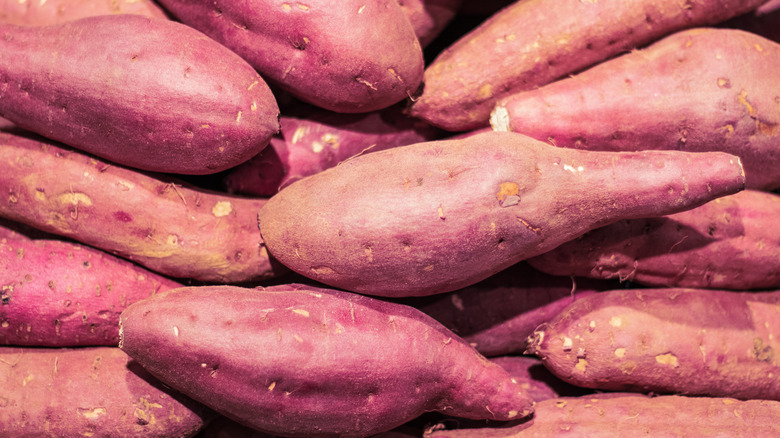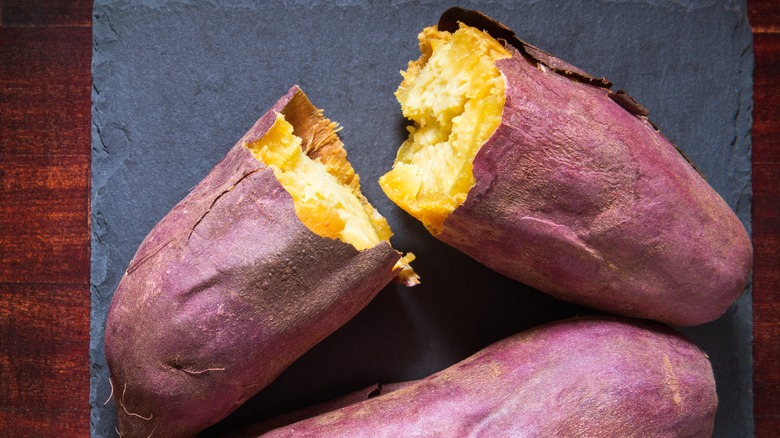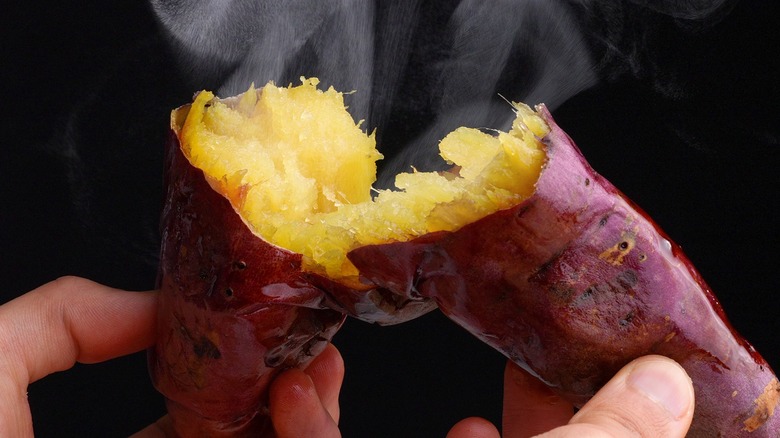What Exactly Are Murasaki Sweet Potatoes And How Do They Taste?
In The Packer 2022 survey results, it was revealed: "About one in three consumers say they have purchased sweet potatoes in the last year." What's not to like? Sweet potatoes have a slightly sweeter bite and a moist and soft texture. However, as you delve deeper into unfamiliar sweet potato varieties, you begin to appreciate subtle differences in flavor. Murasaki sweet potato is a fantastic illustration of the diversity in taste sweet potatoes has to offer.
Murasaki sweet potatoes are often referred to as Japanese sweet potatoes, although they were originally developed in Louisiana. Usually smaller than other sweet potato varieties, Murasaki has a purple, slightly reddish skin with white and ivory tissue beneath. They are similar in appearance to Korean goguma sweet potatoes but hold a unique flavor far from the caramel notes in the goguma. Murasaki sweet potatoes are sweeter than usual, but they possess a nutty undertone instead of presenting a sugary disposition. Murasaki is a brilliant place to begin if you want to expand your sweet potato repertoire.
A Japanese potato, not from Japan
In 1949, Louisiana State University established the Sweet Potato Research Station, which produced the Murasaki variety sometime during the 2000s. So, regarding sweet potato history, which can be traced back to at least 700 years ago, Murasaki is an infant. You might be wondering how any of this relates to Japan. Well, the word "Murasaki" translates to the Japanese word "purple." The alleged inspiration for the name allegedly stems from the sweet potatoes' resemblance to other common Asian potato species.
The singularities of Murasaki are best illustrated when comparing them to the common orange-fleshed sweet potato variety (Jewels, for example). While orange-fleshed varieties have a slightly sugary sweet flavor, Murasaki leans into more earthy tendencies, with aromas of brown sugar, vanilla, and a subtle nuance of chestnut in the background.
While orange-fleshed sweet potatoes' texture is usually watery and moist, Murasaki potatoes are more starchy and dry, possessing a 30-32% dry matter content. This means they'll crisp up wonderfully once cooked, unlike the orange kind, whose shape can crumble. In this sense, Murasaki's dense structure is more similar to an ordinary potato than a sweet one.
A Murasaki feast
There are numerous ways to achieve the best flavor from a purple potato, but what better place to start than with a portion of fries? The dense texture of Murasaki makes them the ideal alternative (perhaps debatably better than orange sweet potatoes). To prepare the Murasaki, peel them and place them into a bowl of water to prevent oxidation from changing their color. Then slice into fries and par-boil before seasoning and baking in the oven. Boiling them first will ensure a fluffy inside and a nice crispy exterior. The Mursaki flesh will also change from that creamy raw color to a darker golden yellow.
It's best to think of cooking with Murasaki like you would a russet potato. Consider mashing it with butter, roasting cubes of it in oil and herbs, or baking it whole in the oven. If you're looking for an earthy-tasting sweet potato that catches the eye and holds its shape, then Murasaki is the one. It serves as a solid first step on your journey to trying other sweet potato varieties.


